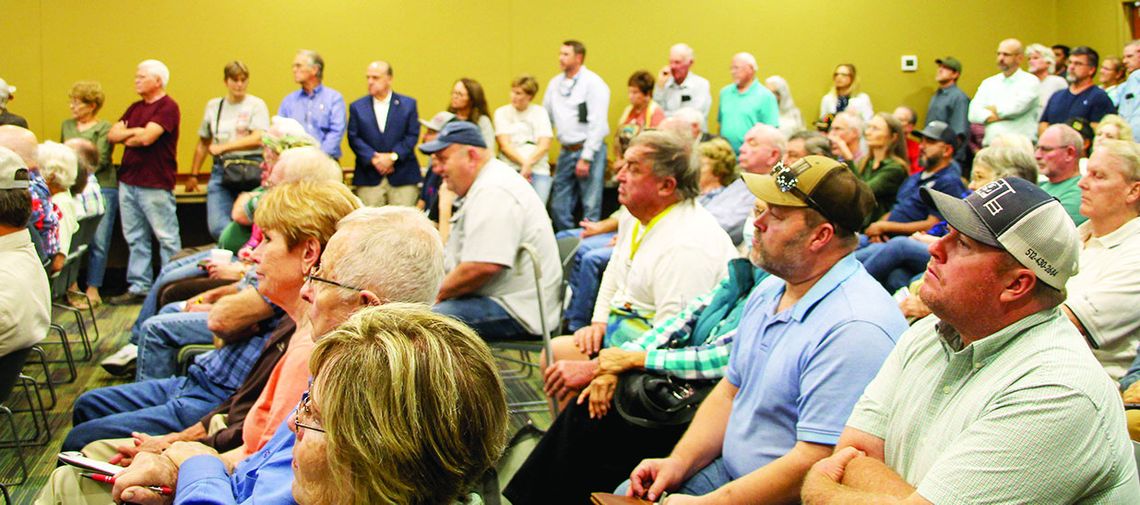Questions and heated exchanges about restricted growth on the city’s fringes took center stage Tuesday during a presentation on Taylor’s Envision Taylor Comprehensive Plan, which controls development.
About 200 people packed the meeting room at the Taylor Public Library to discuss the plan.
At the session, Rebecca Leonard, the CEO of Lionheart Places, the plan’s key consultant, as well as Assistant City Manager Tom Yantis, answered many questions from landowners in the city’s extraterritorial jurisdiction unhappy about the plan’s “restricted growth” designation, which discourages development there due to the high cost of putting in new infrastructure and maintaining it.
The comprehensive plan was adopted by the city in November 2021 to decide how Taylor will grow, and then tweaked to reflect the arrival of Samsung Austin Semiconductor a few months later.
The city is getting more feedback to make revisions for another update by February.
According to Texas law, cities have the authority based on population size to manage growth patterns in their ETJ, which in Taylor’s case, is one mile out from the city limits, except for some areas that petitioned to be included.
Leonard said fiscal sustainability is a major factor that went into deciding where development occurs.
“The restricted area is discouraged because it’s not near anything else,” Leonard said, pointing to the different sectors of the city, which include “intended growth sectors” within the city limits that already have infrastructure available, or in the planning stages, as well as “controlled growth,” which is near existing or future infrastructure, and other designations.
“It’s not near existing infrastructure, and even if the developer pays to put it out there, which is to the tune of millions and millions of dollars, the city still usually has an obligation for maintaining that forevermore, and so that’s why it is discouraged in those areas,” Leonard said. “Now that’s not to say that this map doesn’t need some tweaking and updating. That’s not to say the edges of the map don’t need to be adjusted. We are open to all of those things. “
Leonard said based on calculations, the definition of fiscally sustainable is the value created by the land uses created around infrastructure, such as water, sewer, roads, etc., that could sustain not only the initial construction, but also the every two to three-decade reconstruction of that same infrastructure.
Tom Yantis said that figure came out to about $5,000 per acre of revenue generated for the development.
But not everyone likes the plan.
“I think it has become obvious to me though that if you are in the restricted area, you’re going to have less potential buyers who are going to want to buy your property,” said James Stiba. “And it’s going to drive the value of your property down.”
Bill Albert, who told Taylor Press earlier that he had lost out on an offer of $10 million for his 49 acres near U.S. 79 due to the designation, expressed his frustration.
“The way I heard the restricted growth was, it’s not in the city, but a number of properties are in the city, and they are still assigned restricted growth, and some of them were annexed 20 years ago, and whose job was it to provide the infrastructure?” he said. “I didn’t get any, and I have been paying taxes ever since.”
David Wolbrueck said he thought this plan should be regarded with skepticism.
“What you do is you label this property, and it is worthless. People buy it up, and they turn around and develop it,” Wolbruek said. “The city does not have to stick to any of this plan. The first person that comes along and says if you give me a 50-year tax rebate, I will give you 50 employees, they are going to let you put something out there.”
Mark DeLoach said the city should not be discouraging development in the ETJ and advocated for well-planned Municipal Utility Districts, which are political entities designed to finance utilities through bonds in a specific area.
“We are in a housing shortage as it is right now,” he said. “If you inhibit your growth, all you are going to do is make your real-estate prices go up.”
However, Yantis told the crowd that this plan is pro development, and said the city is currently working on developing a tool to evaluate the fiscal effectiveness of MUDs and other mechanisms.
“This plan is the most growth focused plan that the city has ever adopted,” Yantis said. “There are thousands of acres that are designated for housing development, and we are working with dozens of developers on projects that will add thousands of residential units to the city. We are estimating that we are going to add 6,000 residential units based on our projected population growth over the course of this plan and we tied the growth in housing units to the growth in employment.”
However, several audience members also spoke out in favor of the plan.
Ken Flippin said he had a background in planning and thought the initiative was important to prevent suburban sprawl.
“The infrastructure of this city has been devastated, and it has been devastated because a lot of small towns have been devastated,” he said. “They have been devastated by what? By developers. Look at the ‘80s, the ‘90s, when cities did have growth inside their cities, but it started to go away and why is that? Because sprawl occurred. And that is exactly what developers want to see because they make more money in the short term but if the city has a good comprehensive plan, which I do believe that they have, and I have looked at a lot of them and the city has planned this.”
Still, Yantis and Leonard said they would take this and other feedback into consideration for the updated plan. At-large Councilman Dwayne Ariola, who attended the meeting, encouraged people to reach out to city leaders.
“Now we have developers coming to y’all and presenting you with offers and then holding it against y’all, this restricted growth, you have to continue to provide staff and (City) Council your input on how to iron that out so that you can make your money,” he said.






